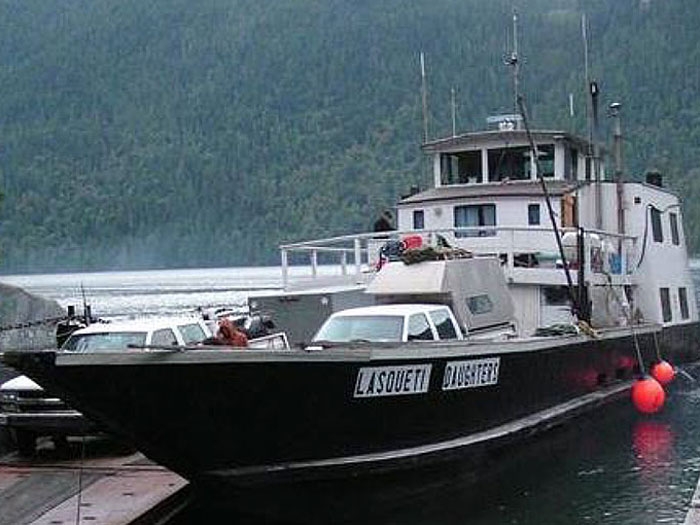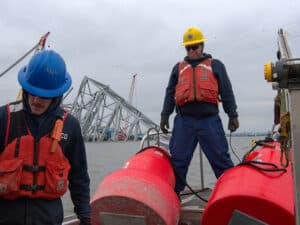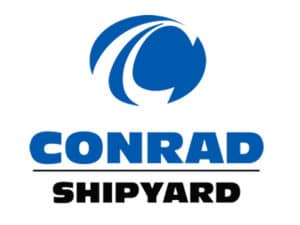
TSB Canada reports on foundering of self propelled barge
Written by Nick Blenkey
Lasqueti Daughters, Stuart Island, British Columbia, 2004
FEBRUARY 3, 2016 — Here’s another of those marine accident investigationts where the summary does not portray the full horrors in the actual report itself.
Released February 1 by the Transportation Safety Board of Canada (TSB) it deals with the foundering and abandonment of the self-propelled barge Lasqueti Daughters. On March 14, 2015, at approximately 1100 Pacific Daylight Time, the vessel with 17 people on board (along with two pickup trucks, an all-terrain vehicle, and 20,000 tree seedlings) departed Campbell River, British Columbia.
Part way into the voyage, the sea conditions deteriorated. Water began shipping on board via the spaces between the bow ramp, the bulwarks, and the main deck, and then downflooded into the forward storage compartment.
The Lasqueti Daughters flooded but remained afloat, was abandoned, and was eventually towed to shore and intentionally beached. There were no injuries. The vessel was declared a constructive total loss.
 From the full report we learn that the “self-propelled barge” was “a shallow-draft self-propelled barge/landing craft constructed of wood with a steel bow ramp.” It was “a homemade vessel, constructed in 2001 on Lasqueti Island, British Columbia. The vessel was not designed with the use of lines plan, nor was it constructed with the use of drawings. The vessel was never inspected during construction, assessed for stability, or registered with Transport Canada (TC) after construction.”
From the full report we learn that the “self-propelled barge” was “a shallow-draft self-propelled barge/landing craft constructed of wood with a steel bow ramp.” It was “a homemade vessel, constructed in 2001 on Lasqueti Island, British Columbia. The vessel was not designed with the use of lines plan, nor was it constructed with the use of drawings. The vessel was never inspected during construction, assessed for stability, or registered with Transport Canada (TC) after construction.”
Lasqueti Daughters with bow ramp down, at Stuart Island, British Columbia, 2004
Transport Canada’s investigation of the incident “also revealed that the master was employed on board in a position for which a certificate of competency was required, but did not hold such a certificate. A Deficiency Notice was issued to the owner, followed by a Notice of Violation. The owner’s authorized representative (AR) subsequently registered the vessel with TC.”
The registered owner of the vessel was Impact Reforestation Ltd. and it was primarily used to transport equipment and workers, and served as a live-aboard camp during silviculture (forestry management)operations.
Here’s how the TSB news release on the report reads:
In its investigation report (M15P0035) released today, the Transportation Safety Board of Canada (TSB) highlighted the lack of safety oversight as a significant risk in the foundering and abandonment involving the self-propelled barge Lasqueti Daughters. Although the vessel was declared a constructive total loss, there were no injuries.
On 14 March 2015, the self-propelled barge, with 17 people on board, departed Campbell River, British Columbia. Partway into the voyage, the sea and wind conditions deteriorated resulting in water pooling on board and making its way into the forward storage compartment. The vessel began foundering and was subsequently abandoned, however it remained afloat and was eventually towed to shore and intentionally beached.
The investigation determined that the weather and sea conditions encountered by the Lasqueti Daughters resulted in water being shipped onto the main deck via the spaces between the bow ramp, the bulwarks, and the main deck. Because the main deck, which had been recently replaced, was not watertight, it allowed water to downflood into the forward storage compartment. The investigation also found that the crew attempted to pump out the storage compartments using the on-board pumps; however, the emergency pump did not pump water, likely due to an air lock, and the remaining pumps could not cope with the ingress of water. As the water continued to enter, the vessel began to founder.
In this occurrence, the owner’s safety program did not cover the marine transportation of workers and equipment required for silviculture operations. The investigation noted that if a company’s health and safety program covers only some of its operations, there is a risk some hazards will not be identified or addressed. Further, if organizations with overlapping areas of responsibility, in this case, WorkSafeBC, the British Columbia Forestry Safety Council and Transport Canada (TC) do not share information and collaborate amongst themselves as well as with owners and masters, then there is a risk that gaps in safety oversight will occur. The investigation also determined that the vessel did not hold the required TC inspection certificate, nor was there any inspection or verification by TC of the vessel’s condition; as such there was no opportunity to identify and address safety deficiencies. The vessel was not operating under a safety management system (SMS), nor was it required to.
The TSB has identified Safety management and oversight as a Watchlist issue. As this occurrence demonstrates, some marine operations are not effectively managing their safety risks. The TSB is calling for all operators in the marine industry to have formal safety management processes with oversight conducted by TC. When companies are unable to effectively manage safety, TC must not only intervene, but do so in a manner that succeeds in changing unsafe operating practices.
The TSB is an independent agency that investigates marine, pipeline, railway and aviation transportation occurrences. Its sole aim is the advancement of transportation safety. It is not the function of the Board to assign fault or determine civil or criminal liability.
Read the full report HERE





Leave a Reply
You must be logged in to post a comment.